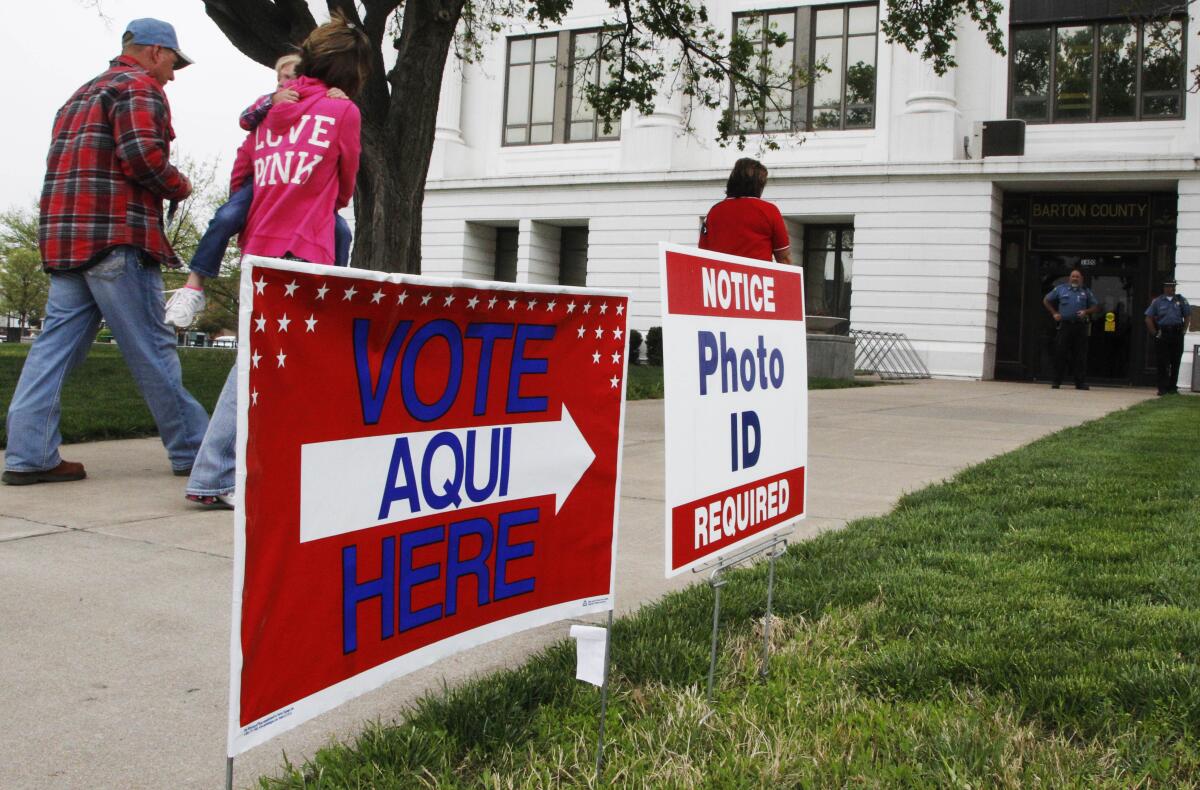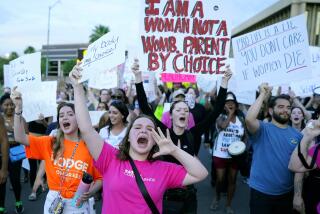Op-Ed: In Kansans’ landslide turnout for abortion rights, a glimpse of post-Dobbs politics

- Share via
The wave of Kansans who turned out on Tuesday and in advance voting to protect abortion rights in the state has given the U.S. its first glimpse of post-Dobbs politics.
When the Supreme Court overturned federal protections for abortion rights in Dobbs vs. Jackson Women’s Health Organization in June, that didn’t end the debate. It rolled a political grenade into every statehouse across the nation.
State legislators, governors and voters have new authority to restrict abortion — a dynamic that could reshape electorates, influencing who turns out and how they vote in this November’s election and for decades to come. Kansas provided the first test of how voters would flex their new power.
Abortion opponents had sought to amend the state constitution, which protects abortion access. They put the question on the ballot in an August primary knowing those tend to have very low turnout and to draw almost exclusively Republican voters, because Democratic races there tend to have uncontested primaries.
We don’t have all the data yet on the demographics of who voted, but it’s clear that abortion opponents’ wish for low turnout didn’t come true. In the most populous county, near Kansas City, this election drew about four times as many advance votes as the 2018 midterm primary had. By the time the polls closed, more than 900,000 people had cast their ballots statewide (with 95% of precincts reporting). That’s stunning for a primary. Even the most recent presidential election drew only 1.3 million voters in Kansas.
Some areas that voted for President Trump in 2020, including in and around Wichita, endorsed abortion rights this week. Statewide, a landslide 59% voted to preserve access in Kansas — a haven for pregnant people who travel from Missouri, Oklahoma and Texas.
Voters nationwide can now see the new battle lines forming. The history of state politics may well be divided into the pre-Dobbs and post-Dobbs eras.
Red states that had not already passed “trigger bans” are probing the ideological limits to see how far they can go to regulate abortion and reproductive healthcare. Right now, Indiana lawmakers appear poised to become the first state to pass a ban on abortion since the Dobbs ruling, with Republican supermajorities in the legislature considering a near-total ban with only narrow exceptions.
Blue states are looking for ways to preserve the right to reproductive choice for their own residents and those seeking access from across state lines. This month, legislators in Sacramento will consider more than a dozen bills that would increase access to abortion options for Californians and those traveling from other states.
Just months ago, “culture wars” in state politics meant fights over critical race theory and bathroom bills; the upcoming battles over abortion rights will make those look like mere skirmishes. It is the behemoth of all social issues, powerfully connected to so many people‘s lives and beliefs. As much as abortion has driven politics in recent decades, imagine how large it will loom in state contests now that federal protections have disappeared.
Our next clues may come from voter registration rolls: If we see a larger-than-usual rise in the number of people registering in September and October, that will show that campaigns have convinced them that Dobbs has raised the stakes of November’s election. Tracking registration rates by party will give us a scoreboard for which side does this better — Republicans looking to consolidate victory by locking in abortion restrictions or Democrats seeking to preserve access to reproductive choice where and when they can.
Campaigns will also leverage the issue to spur turnout among those who planned to sit out what, until Dobbs, looked like a humdrum midterm election. Polls show that there is motivation that could turn into mobilization on both sides. But perhaps the biggest impact could come if voters caught between the party lines are drawn to the polls to make their voice heard on abortion. In the UC San Diego Yankelovich Center Survey fielded this June, we found that it was independents who were most likely to change their mind about participating in the November election after they read news coverage of the abortion debate. Younger women were also especially motivated.
When these newly energized voters cast their ballots, they won’t only be deciding on abortion rights. They’ll be electing state lawmakers who will also — for years to come — drive policy on climate change, schools, vaccinations and perhaps the right of same-sex couples to marry. And, of course, their votes in federal contests will determine who runs the House and Senate in the next session, which sets the stage for the presidential contest in 2024.
Which party will benefit? Social conservatives have been passionate about the abortion issue for generations. But they often turn out at high rates anyway, and this year were already motivated by the opportunity to win control of Congress. The group with the most room to grow in this election, the side that needed the shot in the arm, is Democrats. With their base disenchanted with the Biden administration and frustrated by inflation, it only recently seemed a foregone conclusion that Democrats would lose control of the House and Senate this year. And if independents are drawn into an election that they would have sat out, it will most likely be to vote in favor of abortion rights and the lawmakers who support them.
The Supreme Court lit this political fire, and state lawmakers from both parties are fanning its flames. This just might change whom voters send to Washington in November and beyond.
Thad Kousser is a professor of political science and co-directs the Yankelovich Center for Social Science Research at UC San Diego.
More to Read
A cure for the common opinion
Get thought-provoking perspectives with our weekly newsletter.
You may occasionally receive promotional content from the Los Angeles Times.










